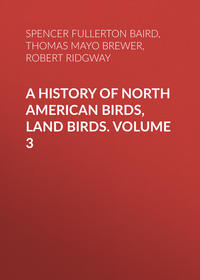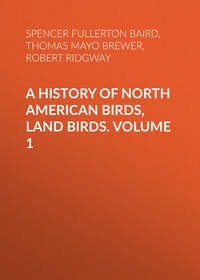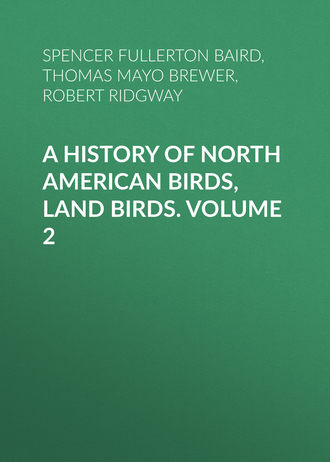 полная версия
полная версияA History of North American Birds, Land Birds. Volume 2
Family ALAUDIDÆ.—The Larks
Char. First primary very short or wanting. Tarsi scutellate anteriorly and posteriorly, with the plates nearly of corresponding position and number. Hind claw very long and nearly straight. Bill short, conical, frontal feathers extending along side of the bill; the nostrils concealed by a tuft of bristly feathers directed forward. Tertials greatly elongate beyond the secondaries.
Subfamilies and GeneraAlaudinæ. Bill stout, short, and conical; nasal fossæ transverse and completely filled by the thick tuft of bristly feathers, and perforated anteriorly by a circular nasal opening. (Old and New World.)
Crown with a depressed soft crest of feathers, of normal structure; a spurious primary; tail deeply emarginate … Alauda.
Crown without a crest, but occiput with an erectile tuft of narrow elongated feathers on each side. No spurious primary; tail square, or slightly rounded … Eremophila.
Calandritinæ. Bill broader, more depressed, and straighter at the base; nasal fossæ longitudinal, large, elongated, the nasal opening rather linear. (Old World.)
Of the Alaudidæ only the two genera diagnosed above belong to the American continent; and one of them is properly only a wanderer from the Old World, while the other is cosmopolitan.
The most characteristic feature of the Larks among other oscine families is seen in the scutellation of the tarsus. The anterior half of this is covered by divided scales lapping round on the sides, but instead of the two plates which go one on each side of the posterior half and unite ultimately behind as an acute ridge, there is but one which laps round on the sides, and is divided into scales like the anterior ones, but alternating with them. The posterior edge of the tarsus is as obtuse as the anterior, instead of being very acute. There is a deep separating groove on the inner side of the tarsus; and there may be really but one plate divided transversely, the edges meeting at this place.
In the elongated hind claw and lengthened tertials, general style of coloration, mode of life, and manner of nesting, there is a decided approximation in the Alaudidæ to the Anthinæ, of the family Motacillidæ; but in these the posterior edge of the tarsus is sharp and undivided transversely, the toes more deeply cleft, the bill more slender, etc.,—their relations being rather nearer to the Sylvicolidæ than to the present family.
Genus ALAUDA, Linn Alauda, Linn. S. N. 1735Gen. Char. Bill very small, less than half the length of the head, conical; nostrils exposed; rictal bristles quite strong; commissure without notch; tarsus much longer than middle toe; lateral toes equal; posterior toe about as long as the middle, its claw longer than the digit, and nearly straight; claws of anterior toe very small. Wing long, pointed, the third and fourth (apparently second and third) quills longest, the second and fifth successively, a little shorter; the first so small as to be almost concealed; tertials much elongated, reaching about half-way from end of secondaries to tip of primaries; their ends emarginated; tail rather deeply emarginated, and a little more than half the length of the wing.
SpeciesA. arvensis. Above grayish-brown, beneath whitish, with a buffy tinge across jugulum and along sides; every feather above with a medial streak of dusky; sides of throat, sides, and across jugulum streaked with dusky; the outer tail-feathers partly white. Wing, 4.90; tail, 2.80; culmen, .40; tarsus, .80; hind claw, .50. Hab. Europe; accidental in Greenland and the Bermudas.
Alauda arvensis, LinnTHE SKYLARKAlauda arvensis, Linn., Faun. Sue. p. 76. Alauda vulgaris, Leach, Syst. Cat. Mamm. and Birds in B. M. p. 21. Alauda cœlipeta, Pall. Zoögr. I, 524. Alauda segetum, Brehm, Vög. Deutschl. 318. Alauda montana, Brehm, Vög. Deutschl. 319, t. 20, f. 1. Alauda agrestis, Brehm, Vög. Deutschl. 320. Alauda italica, Gmel. S. N. I, 793.
Sp. Char. Adult. Above grayish umber-brown, beneath white, tinged across the breast with soft light ochraceous. Every feather above with a medial dusky streak, the shaft black; wing-feathers and upper tail-coverts bordered with white. Outer tail-feather mostly white, the next one edged with the same. A plain, light superciliary stripe; auriculars nearly uniform light brownish; sides of the throat, jugulum, and sides with short streaks of dusky brown.
Male. Wing, 4.90; tail, 2.80; culmen, .40; tarsus, .80; middle toe, .55; hind claw, .50.
Young. Above more yellowish-fulvous, the feathers with central spots, instead of medial stripes of dusky, and bordered terminally with whitish; jugulum washed strongly with ochraceous, and marked with dusky spots.
Hab. Europe; accidental in Greenland and the Bermudas; Aleutian Islands.
Habits. The famed Skylark of the Old World can rest a twofold claim to be included in a complete list of North American birds. One of these is their occasional occurrence in the Bermudas, and in Greenland. The other is their probably successful introduction near New York.
A few years since an attempt was made to introduce these birds, for which purpose several individuals were set at liberty on Long Island. For a short time they did well, and succeeded in raising one or more broods, but, owing probably to the constant persecution of all small birds by the foreign population of the neighborhood, the experiment nearly failed, and none were noticed in that vicinity. Within the last year or two, however, several pairs of these birds have been observed in Westchester County, and also on Long Island, by parties competent to recognize them, and hopes are now entertained that these desirable birds have obtained a foothold in this country.
According to Messrs. Dresser and Sharpe, the Skylark is found throughout the polar Arctic regions, from the British Islands eastward to Siberia and Northern China. A smaller subspecies is met with in Southeastern Europe, which does not present any character by which it can be separated from it. In Eastern Europe the Lark has been found as far north as the Faroe Islands, but has not been observed in Iceland. It reaches Christiania in March, and leaves in October. It has been found breeding in Lapland as far north as latitude 65°, and is a common summer visitant in Finland. Pallas found it abundant throughout Russia and Siberia, and Steller found it not only in Kamtschatka, but equally in the Kurile Islands and in those between Asia and America, so that its occurrence in our Alaskan territories may be regarded as a not improbable event.
The same writers also state that the Skylark has been twice recorded as occurring in Greenland and in America; and in another place they state that “the Skylark occasionally visits Greenland, and has been met with in the Bermudas.” In the latter place a storm-tried waif was taken by Mr. J. M. Jones after an easterly gale.
The Lark is a universal favorite in the Old World, and as a vocalist enjoys a reputation hardly second even to the far-famed Nightingale. It is an inhabitant of all the countries of Europe, and is said to be most abundant in the cultivated districts.
We only know of its song from caged specimens and from the testimony of European writers. Yarrell speaks of its notes as cheerful and exhilarating, fresh as the season of spring, and the admiration of all hearers. Its voice is described as powerful to an extraordinary degree, and its song wild and joyous. They sing while they fly, rising, with quivering wings almost perpendicularly, until they gain so great an elevation that they can no longer be distinguished; yet, while thus no longer visible, their wild music continues to be heard as that of some unseen spirits of the air. It is said that one familiar with their song can readily determine, by their notes, whether the singer is ascending, stationary, or descending. Occasionally, when at this great elevation, the Lark will close its wings and drop to the earth with the rapidity of a stone. At times it will sing while on the ground, but its most lively strains are poured forth during these flights. And though this bird will sing while in confinement, and is a favorite cage-bird, yet in singing they are said to flutter their wings, as if this motion were almost a necessary accompaniment to their song.
In regard to the song and its peculiarities writers are not quite in agreement. The general opinion seems to be that, while in the quality of its tone it is surpassed by the song of the Nightingale, the Bulfinch, and the Black-cap, it is unequalled in quantity, sprightliness, variety, and power. The Lark is in song eight months of the year, and during the summer months it sings from two in the morning, with very little intermission, until after sunset.
Mr. Macgillivray gives an excellent and graphic description of the habits of this bird, from which we extract a portion descriptive of its song. “It has been alleged,” he writes, “that the Lark ascends in a spiral manner, but my observation does not corroborate the statement. In rising it often passes directly upward, but with the body always horizontal, or nearly so, then moves in a curve, and continues thus alternately, but without a continued spiral motion. At first, the motion of the wings is uniformly fluttering; but afterwards it shoots them out two or three times successively at intervals, and when at its greatest height exhibits this action more remarkably. When it descends, the song is not intermitted, but is continued until it approaches the ground, when it usually darts down headlong, and alights abruptly. Frequently it resumes its song after alighting, and continues it for a short time, but more commonly it stops when it has reached the ground. Often a Lark may be seen hovering over a field, in full song, for a considerable time, at a small height. On the 4th of May, 1837, I observed a Lark perched on a half-burnt whin branch, where it remained singing a long time. I have often seen it perch on a wall, and several times on a hawthorn bush in a hedge; but it never, I believe, alights on tall trees.
“The song of the Lark is certainly not musical, for its notes are not finely modulated, nor its tones mellow; but it is cheerful and cheering in the highest degree, and protracted beyond all comparison. In a sunny day in April or May, when the grass-fields have begun to resume their verdure, it is pleasant to listen to the merry songster that makes the welkin ring with its sprightly notes; in the sultry month of July, still more pleasant is it to hear its matin hymn while the dew is yet on the corn; and in winter, should you chance to hear the well-known voice on high, it reminds you of the bright days that have gone, and fills you with anticipation of those that are to come. No doubt much of the pleasure derived from the Lark’s song depends upon association, but independently of circumstances and associations the song of the Lark imparts an elasticity to the mind, elevates the spirits, and suspends for a time the gnawing of corroding care. The carol of the Lark, like the lively fife, excites pure cheerfulness. In confinement this bird sings every whit as well as when at large, and when rapidly perambulating the square bit of faded turf in its cage, it enacts its part with apparently as much delight as when mounting toward heaven’s gate.”
This bird succeeds well in cages, and lives to a great age, Yarrell mentioning one that lived nearly twenty years in confinement. Its natural food is grain, the seeds of grasses, worms, and various kinds of insects. They begin to mate in April, and have two broods in a season. Their nest is always placed on the ground, often sheltered by a tuft of grass, or some other protection. The nests are woven of coarse grasses and stems of plants, and are lined with finer materials of the same. The eggs are five in number, have a grayish-white ground, occasionally a greenish-white, very generally sprinkled and blotched with markings of dark-gray and an ashy-brown, so profusely as to conceal the ground. They are oval in shape, slightly more pointed at one end, and measure .93 of an inch in length by .70 in breadth.
According to Selby, the young of the first brood are fully fledged by the end of June, and the second in August. The Lark evinces a very strong attachment to its young, and many interesting accounts are given by European writers of its intelligent endeavors to conceal and to protect its nest,—in one instance constructing an artificial dome of dry grass, where the natural protection had been cut away by mowers, and in another attempting to remove the young to a place of greater safety.
The Lark has, in several instances, been successfully induced to mate and rear her young in an aviary; and Mr. W. P. Foster, of Hackney, is quoted by Mr. Yarrell as authority for the statement, that, during the period of producing the eggs, the female has been heard to sing with a power and a variety of tone equal to the voice of her mate.
While his mate is sitting on her eggs, the male Lark, apparently timid at all other times, is remarkably bold, and drives away other birds that venture too near their nest. He not only watches over her and seeks to protect her, but assiduously supplies her with food.
Genus EREMOPHILA, BoieEremophila, Boie, Isis, 1828, 322. (Type, Alauda alpestris. Sufficiently distinct from Eremophilus, Humboldt, [Fishes,] 1805.)
Phileremos, Brehm, Deutschl. Vögel, 1831.
Otocoris, Bonaparte, 1839. (Type, Alauda alpestris, Gray.) (We are unable to find where the genus is named.)
Gen. Char. First primary wanting; bill scarcely higher than broad; nostrils circular, concealed by a dense tuft of feathers; the nasal fossæ oblique. A pectoral crescent and cheek-patches of black.

♂ Eremophila alpestris.
This genus differs from Melanocorypha in having no spurious first primary, although the other characters are somewhat similar. Calandritis of Cabanis, with the same lack of first primary, has a much stouter bill. The spurious primary, more depressed bill, and differently constituted nostrils and nasal fossæ of Alauda are readily distinctive.

Eremophila alpestris.
The type of this genus is the Alauda alpestris, Linn., a well-known cosmopolitan species, though the birds of the New World have been distinguished under distinctive names, as cornuta, chrysolæma, peregrina, etc. The examination and critical comparison of more than a hundred specimens from all parts of North America, however, has convinced us of the identity with alpestris of the several forms mentioned above, though it may be advisable to retain one or more of them as geographical races.
Species and VarietiesE. alpestris. Adult. Above pinkish-gray, varying to cinnamon, the pinkish deepest on nape and lesser wing-coverts; tail black (except two middle feathers), the outer feather edged with white. Beneath white, the sides pinkish or grayish. A frontal band and superciliary stripe, the middle of auriculars, chin, and throat varying from white to deep Naples-yellow; forepart of crown, and “ear-tufts,” a patch on lores and cheeks, and a broad crescent across the jugulum, deep black; end of auriculars ashy. Female and autumnal males, with the pattern less sharply defined, and the colors more suffused. Young. Brownish-black above, more or less mixed with clay-color, and sprinkled with whitish dots; wing-feathers all bordered with whitish. Beneath white. Markings on head and jugulum just merely indicated by dusky cloudings.
Wing (of adult male), 4.20 to 4.60; tail, 2.90 to 3.16; culmen, .60 to .65.
White frontal band, .25 to .30, wide; the black prefrontal patch, .26 to .35 wide. The pinkish above of an ashy-lilac shade.
Throat and forehead white, with only a very faint tinge of yellow; pinkish tinge above more rufous. Hab. Interior Northern Plains of the United States … var. occidentalis.
Throat and forehead pale straw-yellow, or strongly tinged with it; pinkish tinge above varying from ashy-lilacous to purplish-rufous. Hab. Northern regions of Old and New Worlds … var. alpestris.
Wing (adult male), 3.80 to 4.10; tail, 2.75 to 2.90; culmen, .53 to .62.
White frontal band, .13 to .16 wide; the black prefrontal patch, .35 to .50 wide. Pinkish above of a deep cinnamon shade. Hab. Desert plains of South Middle Province of United States, and table-lands of Mexico, south to Bogota … var. chrysolæma.
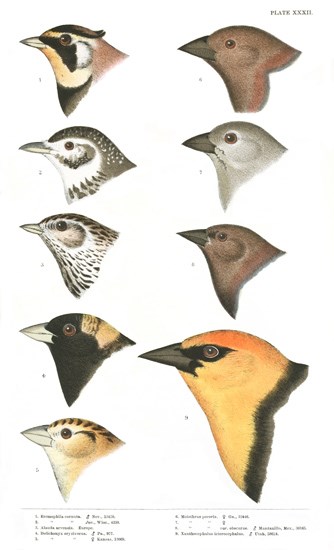
PLATE XXXII.
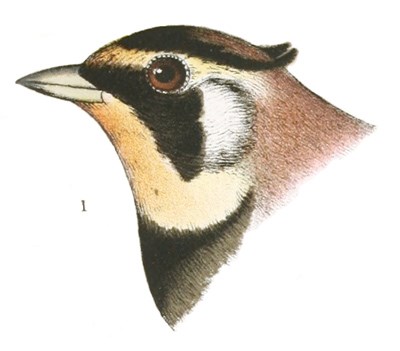
1. Eremophila cornuta. ♂ Nev., 53470.
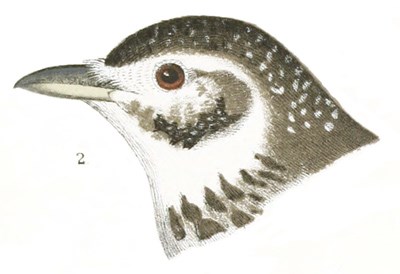
2. Eremophila cornuta. Juv., Wisc., 4330.
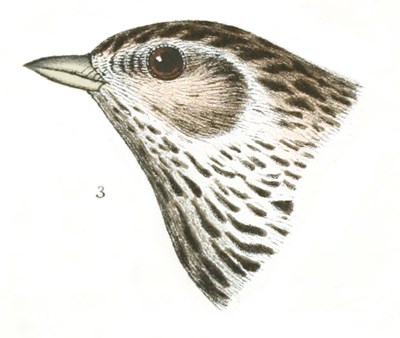
3. Alauda arvensis. Europe.

4. ♂ Pa., 977.

5. Dolichonyx oryzivorus. ♀ Kansas, 13069.
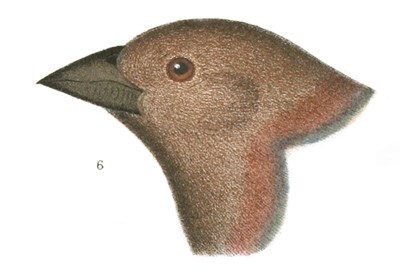
6. Molothrus pecoris. ♀ Ga., 32446.

7. Molothrus pecoris. ♀
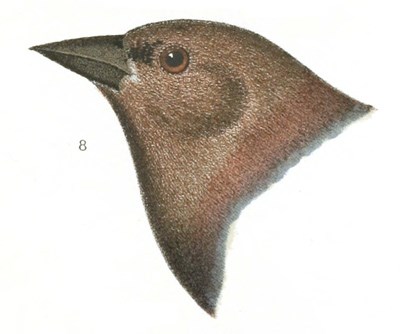
8. Molothrus pecoris. var. obscurus. ♂ Manzanillo, Mex., 30165.
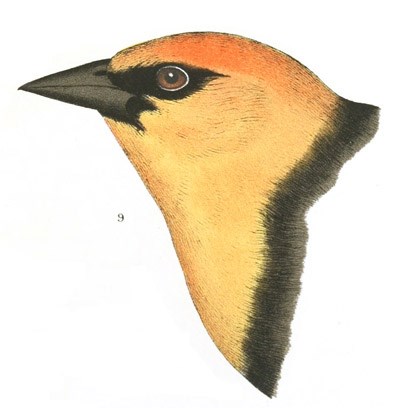
9. Xanthocephalus icterocephalus. ♂ Utah, 58624.
Eremophila alpestris, BoieTHE SHORE LARK
Sp. Char. Adult male; spring. A frontal crescent, curving backward in a broad, sharply defined, superciliary stripe to the occiput; chin, throat and foreneck, and a crescent across middle of ear-coverts, whitish, either more or less tinged with yellow, or pure white. Lower parts, except laterally, white. A broad crescentic patch behind the frontal whitish crescent, running back on each side of the crown and terminating in an erectile tuft of narrow elongated feathers on each side of occiput, a patch covering the lores, nasal tufts, passing beneath the eye, and forming a broad “mustache” on the cheeks, with a convex outline behind and concave anteriorly, and a broad crescentic patch across the jugulum, deep black. A crescentic spot of grayish-drab across the ends of the auriculars. Posterior portion of the crown enclosed laterally between the “ear-tufts,” occiput, nape, lateral lower parts, lesser and middle wing-coverts, and upper tail-coverts, pinkish-brown; the sides and flanks with obsolete dusky streaks. Back, scapulars, rump, wings, and two middle tail-feathers, ashy-drab, the feathers darker centrally, forming rather conspicuous broad streaks on lower part of back; middle and secondary coverts, secondaries and primaries bordered terminally, quite conspicuously, with white. Tail (except the intermediæ) black; outer web of lateral feather almost entirely white, that of the next edged with the same.
Adult female; spring. Similar, but markings rather less sharply defined; a tendency to streaking of nape and crown; these streaks often displacing the continuous black of the anterior portion of crown. The “ear-tufts” less developed.
Winter adult. Similar to the spring dress, but the black areas obscured, more or less, by whitish borders to the feathers; the frontal whitish band less sharply defined. Breast with numerous more or less distinct deltoid specks of plumbeous, and the pinkish of the sides much tinged with the same. The dusky streaks above are broader and more conspicuous.
Young. First plumage, entirely different from the adult. Above dusky, variegated with whitish dots, sprinkled over the whole surface; these specks terminal on each feather, and of a deltoid form, becoming more transverse and crescentic on the scapulars and rump; each feather of the wings broadly bordered with pale brownish, approaching white on the coverts. The blackish areas are but faintly indicated by a dusky suffusion, generally very indistinct, across the breast, and over the cheeks; and variegated with badly defined, more dusky spots; lower parts, including post-ocular stripe, dull white; sides spotted with dusky.
The E. alpestris, as restricted, is represented in the collection by three perfect specimens, in the several stages of plumage described; while there is also a fine specimen from Astrachan, representing a white-throated race (“var. bei” on MS. label) of Central Asia. The series of American specimens is all that could possibly be desired, there being numerous examples from nearly the whole northern continent, from the Arctic regions to as far south as Bogota, and from coast to coast.
The common Shore Lark of the northern parts of North America appears to be absolutely identical with the European bird, each of the specimens of the latter being easily matched from the American series. It therefore becomes necessary to reduce the name “cornuta” to a synonyme of alpestris, the former not affording characters to distinguish it as even a variety. To alpestris may also be referred the form known as “occidentalis, McCall,” those specimens from the interior regions which are destitute of any yellow tinge on the throat. Were this feature a constant one in specimens from the region which it characterizes, it would be, of course, right to retain the name in the form of alpestris var. occidentalis. As it is, however, quite a large percentage of the specimens from every locality where occidentalis is found have more or less yellow throats, but it is possible that this mixture of the two may be the result of irregular migrations, those yellow-throated individuals being stragglers from their breeding habitat,—more to the eastward and northward. In its white instead of straw-yellow throat, and more lilaceous than vinaceous upper parts, this form bears a close resemblance to a race of the deserts of Western (and Central?) Asia,—the “bei”26; the latter, however, has these features more exaggerated than in the one of the central plains of North America. Breeding throughout the table-lands of Mexico, and in the Western Province of the United States, north to about the 40th parallel, is a more strongly marked race, maintaining also more constancy in its peculiar features; this race is the E. chrysolæma, Wagl., of which name rufa, Aud., and minor, Giraud, are synonymes. This race, which we propose to call E. alpestris var. chrysolæma, differs from both the northern styles in smaller size and longer bill, and in coloration is the opposite extreme from occidentalis, having the vinaceous tints deeper and browner, instead of paler and less brown, than in cornuta (i. e. typical alpestris). The black markings are also more extended, in proportion to the other colors, reducing the white on the forehead to a very narrow band, instead of a broad spot equalling, or exceeding, the black in width. Specimens from Bogota—about the southern limit of the genus on this continent—are, perhaps, referrible to chrysolæma, or at least not very different from it, though described by Sclater as distinct, under the name peregrinus.27
In fewer words, the variations, with the region, are about as follows. Starting with North America, north of the United States, we begin with a style absolutely undistinguishable from that of Europe; this, to which the name cornuta belongs, visits the Eastern States only in winter, but breeds over the prairie region of Wisconsin, Illinois, and westward. West of the Rocky Mountains, especially south of about 40°, specimens referrible to this style are most numerous in winter, and in a large series a great percentage of the specimens entirely lack any yellow on the throat, while the pinkish-brown tints are lighter and less reddish; this style represents, in these peculiar features, the “var. bei” of Western Asia (Astrachan), and has been distinguished by the name occidentalis, McCall, though it is doubtful whether McCall’s description is of a specimen of this style or of one of chrysolæma, being taken from a young or immature bird. Breeding south of about 40°, from the Rocky Mountains to the Pacific coast, and throughout the table-lands of Mexico,—in winter sometimes resident at the northern limit assigned, and there mixed with northern-bred individuals,—is a kind which is smaller, and, generally, with a larger bill; the throat is deeper yellow than in the northern form, the pinkish tints deepened into cinnamon, and the frontal band narrower, caused by an encroachment of the black, which, in its several areas, is extended more in proportion to the other colors. This is the E. chrysolæma of Wagl., and of which minor, Giraud, and rufa, Aud., are synonymes, as already stated.


